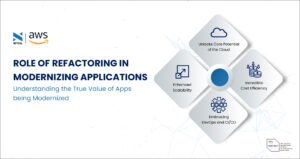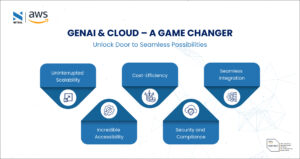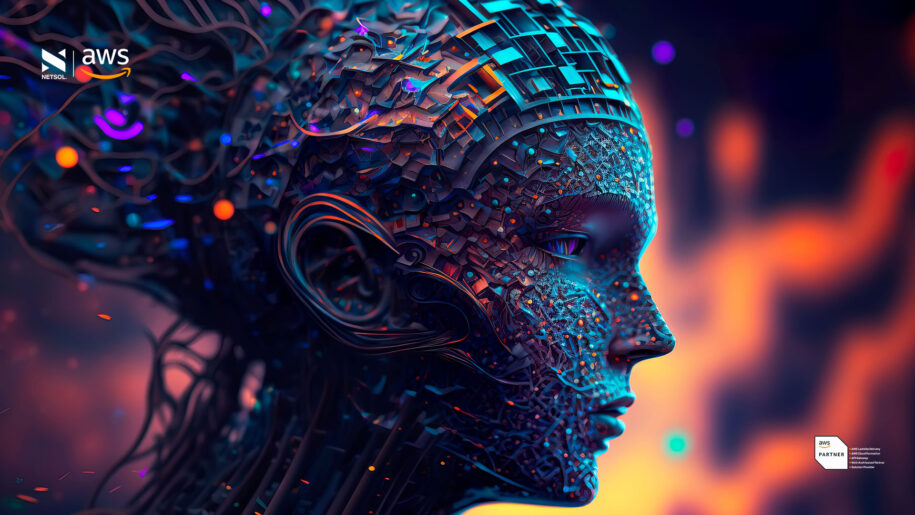Imagine standing at the cusp of a digital revolution, where you are witnessing the transformation in terms of how we live, work, and interact around the world. Giving goosebumps, right? This isn’t science fiction anymore; you are witnessing the most technological time of the 21st century, living around game-changing inventions, concepts, and prototypes.
We know the tech landscape is prone to constant evolution, introducing new and mightier concepts and altering the world. And amidst this, two powerful forces are emerging, disrupting every concept known to mankind: Cloud Computing and Generative Artificial Intelligence (GENAI). Individually, these technologies are already creating an everlasting impact on modern businesses and society at large.
As what is commonly observed, when two powerful forces are infused together, they form a formidable alliance that promises to reshape industries and lead us into a revolutionary future. Let’s travel down Gen AI lane and explore how this synergy leads us up the exciting modernization pathway.
The Cloud: Where It All Begins
Before diving into the fascinating world of Generative AI in software development, let’s take a breather and cover the basics first!
Cloud computing is no longer a buzzword; it’s a technological marvel that has become essential to our daily lives. Since its inception, cloud computing has come a long way! Initially, it was a simple way to store the data and run the applications remotely, reducing the need for costly on-premises infrastructure.
Today, it has evolved into a versatile platform that provides computing power, storage, and various services on demand. This evolution has opened the door to unprecedented scalability, cost-efficiency, and global accessibility for businesses of all sizes.
Cloud computing is not just a means to host applications; it also has the potential to drive innovation. It has become the foundation for modern technologies, allowing for swift development, deployment, and scaling of applications and services.
Google Generative AI: The Art of Creativity
Now, let’s talk about the real star of the show: Google Cloud Generative AI. This is where machines get creative, and trust me, they’re impressively good at it. Generative AI PoC uses algorithms and neural networks to generate content – from text and images to music. It’s like having your very own digital Picasso.
Generative AI transforms various industries by automating tasks, enhancing creativity, and driving efficiency. For instance, among the uses of Generative AI, it generates realistic images, writes compelling content, and even assists in drug discovery. Its potential applications are vast and varied, making it an invaluable tool for modernization.
Modernizing Applications for the Cloud
Businesses must have a well-established infrastructure to make the most of new technologies and unleash the power of GENAI. Migrating applications into the cloud is unique to each company’s workload complexity and application portfolio. However, certain methods are more effective than others.
Modernizing an application for the cloud requires careful consideration of different techniques such as rehosting, refactoring, re-architecting, rebuilding, and replacing. Depending on an organization’s unique needs and existing environment, a combination of these methods may be necessary. The ultimate goal of successful application modernization is to enhance business and IT agility and scalability. Re-platforming and refactoring are the most efficiently used approaches that leverage cloud services and solution patterns.
As part of this process, applications are typically refactored into microservices in containers or functions, with advanced data platforms and services facilitating better information flow. Infrastructure-as-code and DevOps pipelines are also implemented to automate application development and deployment. This approach ensures a more thoughtful, confident, sincere, enthusiastic, optimistic, informative, friendly, interested, and positive experience for organizations seeking to modernize their applications for the cloud.
Refactoring and re-platforming can assist in easily modernizing the applications, where GENAI can handle the rest. This is why Generative AI is important, changing the world around us with the power of cloud computing.
Refactoring – Changing the Ways of Modernizing Apps on Cloud
In the digital age, businesses constantly strive to enhance their agility, scalability, and efficiency to stay competitive. Refactoring is crucial in modernizing applications and is pivotal in transforming legacy applications into highly adaptable, cost-effective, cloud-native solutions. In this context, with Google Generative AI in view, refactoring becomes even more essential to prepare applications for the cloud. Let’s delve into why that is.

Unlocks Core Potential of the Cloud
The cloud provides many resources and services, including auto-scaling, serverless computing, and managed databases, that can significantly improve an application’s performance and cost-effectiveness. However, applications must be customized for the cloud environment to utilize these benefits fully. Refactoring allows you to restructure your application’s architecture to exploit these cloud-native features.
Enhanced Scalability
Scalability is one of the most essential features of cloud computing. Applications must quickly adjust to different workloads, whether scaling up or scaling down. Often, monolithic applications are refactored into smaller microservices, which can be scaled independently. This granular approach to scaling allows you to use only the resources you need, making it more cost-effective.
Incredible Cost Efficiency
Cloud costs have the potential to become unmanageable if applications are not optimized. Refactoring can be a valuable approach to alleviate these costs by properly sizing resources, automating infrastructure provisioning, and implementing cost monitoring and optimization strategies.
Embracing DevOps and CI/CD
Refactoring is often done in conjunction with implementing DevOps methodologies and Continuous Integration/Continuous Deployment (CI/CD) pipelines. You can facilitate faster and more dependable releases by breaking down monolithic applications into microservices and automating deployment processes.
Generative AI and Cloud Computing – The Infusion!
Imagine a world where AI turbocharges creative content creation, software development, and problem-solving. It is the promise of combining GENAI and the cloud. Here’s why it’s a game-changer:

Uninterrupted Scalability
The cloud’s ability to scale resources on demand aligns perfectly with the resource-intensive nature of Generative AI. Whether you’re generating art, writing code, or analyzing data, the cloud can provide the computational muscle you need.
Incredible Accessibility
Cloud resources are accessible from anywhere with an internet connection. So, what does this mean for your business? By leveraging Generative AI and the cloud, you can deploy any application globally, fostering collaboration and innovation on a global scale.
Cost-Efficiency
Pay-as-you-go pricing models offered by reliable cloud providers allow businesses to control costs effectively. You only pay for your computing power, making it cost-efficient to experiment with Generative AI in software development.
Security and Compliance
Cloud providers invest heavily in security measures and compliance certifications to ensure that GENAI applications meet the highest security and compliance standards.
Seamless Integration
Cloud ecosystems offer myriad tools and services that can be seamlessly integrated with your Google Cloud Generative AI applications, enhancing their capabilities and functionality.
The Path Forward!
Modernization is not just a one-time effort; it’s an ongoing journey. By incorporating cutting-edge Generative AI app builder technology through the cloud, you’re setting yourself up for a future full of endless possibilities and innovation.
Following a few critical steps is essential to ensure your successful transition to a Generative AI and cloud-based infrastructure. Here are some guidelines to help you get started:
- Assess Your Infrastructure: Evaluate your current IT infrastructure and determine how well it aligns with your Generative AI goals. Identify the areas that require modernization to optimize for GENAI.
- Choose the Right Cloud Provider: Select a reliable cloud provider that aligns with your business needs, budget, and security requirements. Consider your provider’s Generative AI services and support to ensure they are compatible with your goals.
- Plan Your Transition: Develop a clear migration plan for moving your applications and data to the cloud. Consider the architectural changes necessary to optimize for GENAI. Ensure to involve all stakeholders in the planning process to avoid surprises.
- Leveraging Generative AI Services: Explore cloud providers’ GENAI services or integrate third-party GENAI solutions into your cloud environment. It will help you maximize the benefits of GENAI for your business.
- Train and Educate: Invest in training and education to equip your team with the skills needed to work effectively with GENAI and the cloud. It will ensure that your team is ready to take full advantage of the potential of Generative AI and cloud computing.
By embracing this powerful synergy, you’ll be able to thrive in the ever-changing world of technology and creativity. So why wait? The future is calling, full of excitement and opportunities just waiting for you to seize them!
Contact NETSOL to schedule a meeting and discuss the possibilities and benefits you can unlock with Generative AI and Cloud Computing today!



Leave a Reply